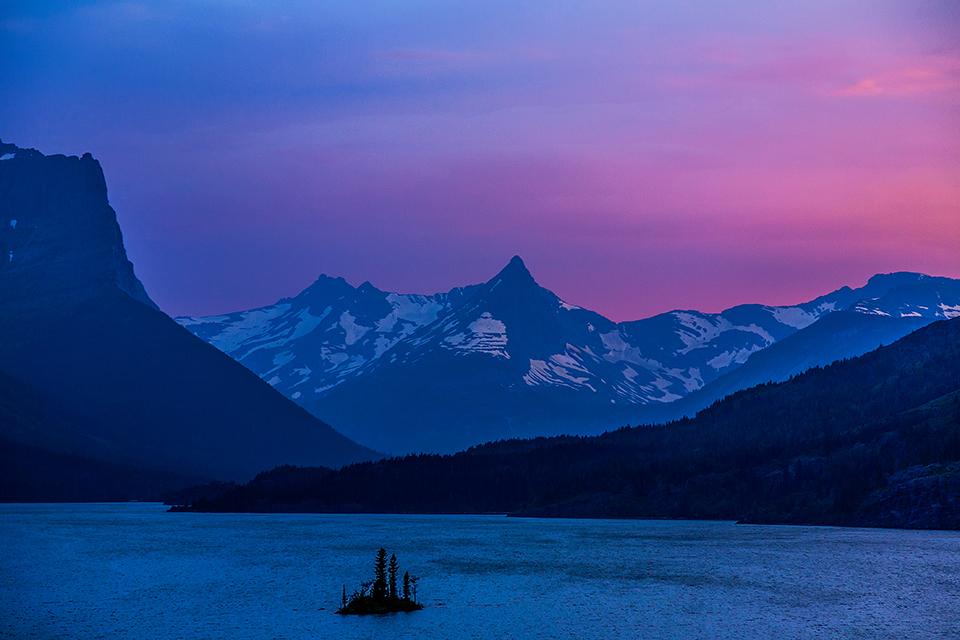
A summer sunset over Wild Goose Island, Glacier National Park / Rebecca Latson
In addition to the month of May being notable for Mother’s Day and Memorial Day, it’s also the month in which Glacier, Carlsbad, and Crater Lake national parks were established, as well as the founding of the National Parks Conservation Association and the Sierra Club. So, guess what this quiz and trivia piece is all about? Test your knowledge with the questions first, before looking at the answers at the bottom of this piece.
1. Who co-founded the Sierra Club?
a) Lady Bird Johnson
b) John Muir
c) Horace Albright
d) Theodore Roosevelt
2. When was the National Parks Conservation Association Founded?
a) 1900
b) 1919
c) 1925
d) 1930

The Lake McDonald Lodge lobby, Glacier National Park / Rebecca Latson
3. Before there was Lake McDonald Lodge, there was another hotel in that spot within Glacier National Park:
a) Snyder Hotel
b) Belton Hotel
c) Avalanche Creek Hotel
d) Lake Hotel
4. In Glacier National Park, one of the first trees you’ll see sprouting up immediately after a fire is the:
a) ponderosa pine
b) lodgepole pine
c) Douglas fir
d) white pine

Exploring Sherwood Forest, Carlsbad Caverns National Park / NPS-Peter Jones
5. Carlsbad Cavern is one of over ___ limestone caves in “a fossil reef laid down by an inland sea 250 to 280 million years ago.”
a) 100
b) 150
c) 200
d) 300
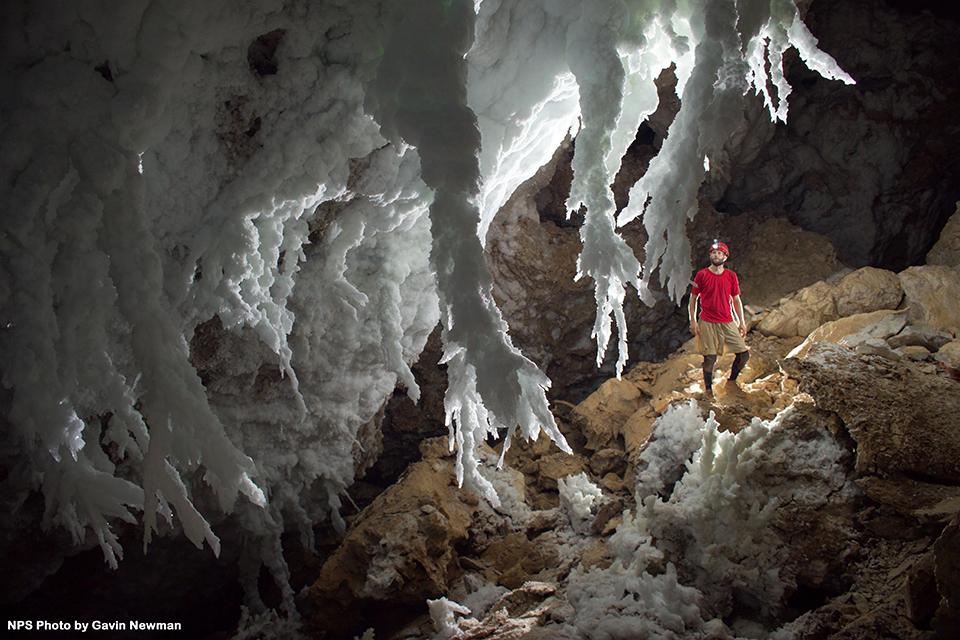
The Chandelier Ballroom of Lechuguilla Cave, Carlsbad Caverns National Park / NPS-Gavin Newman
6. True or False: Lechuguilla Cave, located in Carlsbad Caverns National Park, is the deepest limestone cave in the country.
a) True
b) False
7. When exploring Crater Lake National Park in the winter, it’s best not to get too close to the edge of the snow-blanketed rim because of the overhanging deposits of snow known as _____.
a) terrain traps
b) snow cornices
c) roofalanches
d) snow devils
8. A number of national parks have endemic species. These are species whose range is restricted to a particular geographical area found nowhere else. Crater Lake is home to an endemic species of amphibian:
a) Mazama newt
b) imitator salamander
c) long-toed salamander
d) rough-skinned newt
9. True or False: Crater Lake has been known to completely freeze over.
a) True
b) False
10. True or False: The Sierra Club’s youngest charter member was 5 years old.
a) True
b) False
Trivia
Glacier National Park's first superintendent was Major William Logan. Logan lived in Montana off and on for many years, and had explored the Glacier area on survey crews. In the park's first year there were few trails and practically no roads. The first headquarters were tents on Lake McDonald. To read more about this park’s personnel, click here. To read more about William Logan and Glacier National Park history, click here.
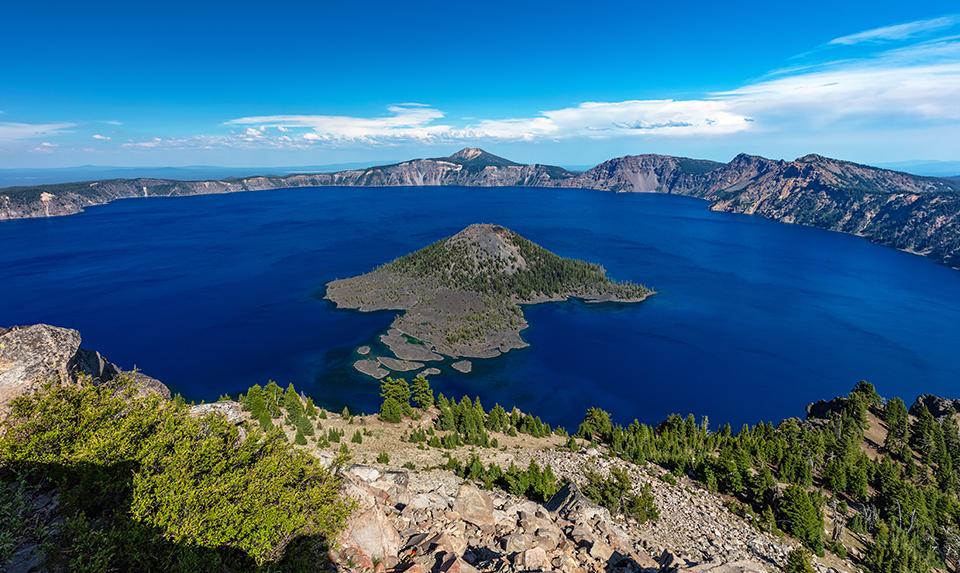
Incredible blue lake water, Crater Lake National Park / Rebecca Latson
One of the things you’ve probably noted during a visit to Crater Lake is how very blue it is. “The water [in Crater Lake] is so blue because there is hardly anything else in it - just water. It's not pure water, but it's close. We've all seen the colors in a rainbow when normal white light passes through a raindrop and breaks into the individual colors of the spectrum. All those colors are in sunlight. The reason different objects appear to be different colors lies in the molecular structure of the chemicals that make up that object. For example, a red shirt appears red because the chemicals in the fabric dye are put together in a way that absorbs all of the colors except red. The red wavelengths then bounce back, hit our retina, and our brain sees "red." Water molecules, just plain water with no sediments, algae, pesticides or pollution, will absorb all the colors of the spectrum except the blues. Those wavelengths will bounce back and make the water appear blue. The key is to have relatively pure water and lots of it. There have to be enough molecules to absorb all the other colors. (There are 4.6 trillion gallons of water in the lake, so it works really well.)”
The six charter members who formed the National Parks Conservation Association (then known as the National Parks Association) were quite notable for a number of things. All were members of the National Parks Educational Committee. “Sculptor Henry Kirke Bush-Brown was the creator of three equestrian bronzes that still stand at Gettysburg National Military Park. William Henry Holmes, the namesake of Yellowstone’s Mount Holmes, was a noted archaeologist who would become director of the National Gallery of Art. Anthropologist Jesse Walter Fewkes had led excavations of Casa Grande and Mesa Verde and called for legislation to stem the vandalism of ancient sites in the Southwest. Attorney Henry Brown Floyd McFarland was a onetime newspaper reporter and president of the Washington, D.C. Board of Commissioners. Paleontologist Charles Doolittle Wolcott was the administrator of the Smithsonian Institution and previously had served as director of the U.S. Geological Survey. Led by committee founder Robert Sterling Yard, an inveterate writer turned promoter of the national parks, the six men signed the articles of incorporation forming a new organization with a mission to educate the American public about the nation’s parks and to inspire them to experience and protect them. The National Parks Association — known today as the National Parks Conservation Association — was born.”
Quiz Answers
1b
John Muir co-founded the Sierra Club with a group of professors on May 28, 1892.
2b
On May 19,1919, “Robert Sterling Yard and a cadre of scientists, artists and civic leaders signed the articles of incorporation that established the National Parks Association (NPA) – known today as the National Parks Conservation Association (NPCA).”
3a
“Originally there was the Snyder Hotel, which John Lewis bought in 1896. During the winter of 1913-14, Lewis had a new 65-room hotel built on the site. Construction materials that could not be locally sourced had to be hauled from the depot in Belton then ferried nearly 10 miles up lake. The Lewis Hotel, decorated as a hunting lodge, was a community gathering point where artist Charlie Russell could sometimes be found telling stories in the lobby. In 1930, Lewis sold the property. New management changed the hotel's name to Lake McDonald Lodge.” To read more about the historic lodges and chalets of Glacier National Park, click here.
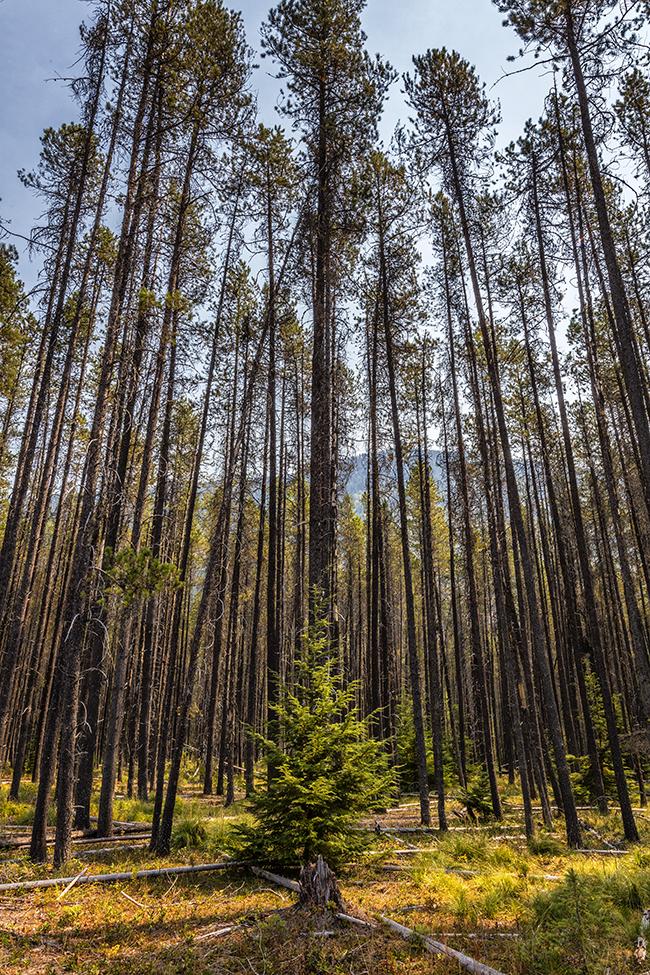
Lodgepole pines standing straight and tall, Glacier National Park / Rebecca Latson
4b
“Uniform, even-aged stands of lodgepole pine reflect the recent fire history of the park, because their serotinous seed cones open and re-seed immediately following fire.” To read more about the trees and shrubs you’ll see in Glacier National Park, click here.
5d
“Carlsbad Cavern is one of over 300 limestone caves in a fossil reef laid down by an inland sea 250 to 280 million years ago. Between four and six million years ago, hydrogen-sulfide-rich (H2S) waters began to migrate through fractures and faults in the Capitan limestone. This water mixed with rainwater moving downward from the surface. When the two waters mixed, the H2S combined with the oxygen carried by the rainwater and formed sulfuric acid (H2SO4). This acid dissolved the limestone along fractures and folds in the rock to form Carlsbad Cavern. This process left behind massive gypsum deposits, clay, and silt as evidence of how the cave was formed.” To learn more about caves and karst systems, click here.
6b False
Lechuguilla Cave, with a depth of 1,604 feet (approx. 489 meters) is the second deepest limestone cave in the country. At one time not too long ago, it was considered the deepest limestone cave, but that distinction is now awarded to Tears of the Turtle Cave, in western Montana, with a depth of 1,659 feet (approx. 506 meters). To learn more about Lechuguilla Cave, click here.
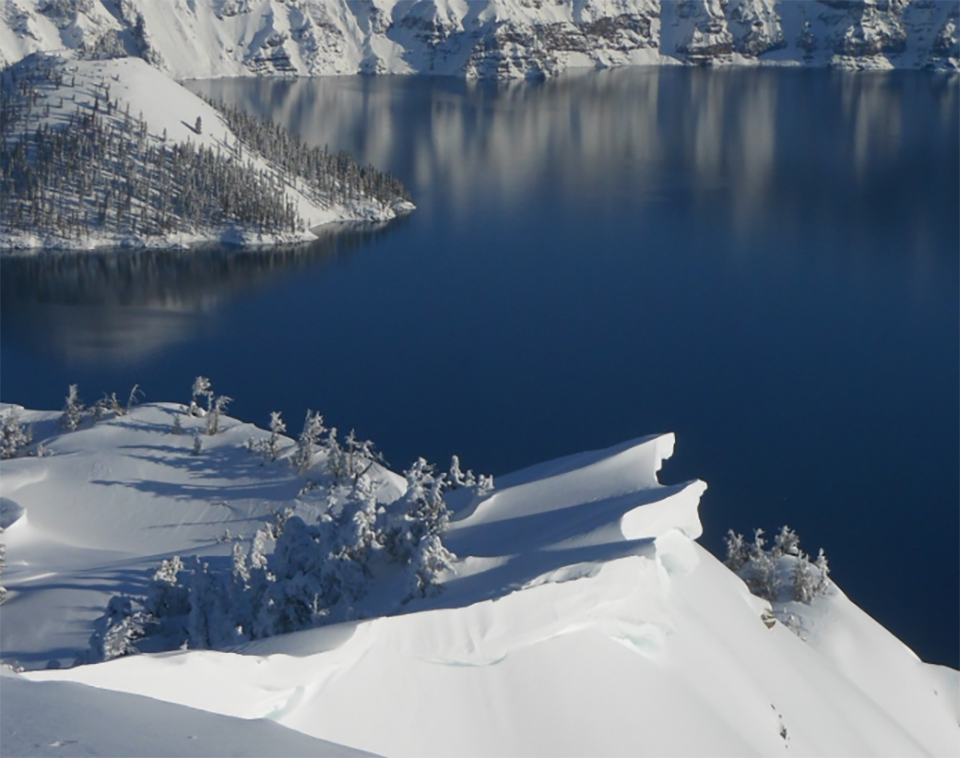
A snow cornice on Garfield Peak, Crater Lake National Park / National Park Service
7b
“Snow cornices are overhanging deposits of snow formed as wind blows snow over an edge. Cornices are difficult to identify from above and can extend beyond the rim of the caldera ten feet or more. They can collapse when weight is added to them. You might walk onto a cornice without knowing it. When near the rim of the caldera, stay well away from the edge—what appears to be solid ground may be a cornice that could give way.” To learn more about snow safety, click here.
8a
“The Mazama newt Taricha granulosa mazamae, is an endemic species to Crater Lake National Park. It only lives along the shores of Crater Lake and Wizard Island.”
9a True
The lake has frozen over, but it’s a rare occurrence due to the fact that Crater Lake’s “weather systems generally come off the Pacific Ocean. Though this means a great deal of precipitation (usually snow,) oceans are a moderating force for temperature meaning it rarely gets cold enough to freeze so much water. The last complete surface freeze was in 1949. A 95% freeze occurred in 1985.”
10b False
The Sierra Club’s youngest charter member was John Muir’s 11-year old daughter.
References
In addition to the information taken from each NPS park website, the following references were used for this quiz and trivia piece.
https://www.npca.org/campaigns/our-history
Note: Different websites may have different national park establishment dates, so, I used this NPS publication as the standard.



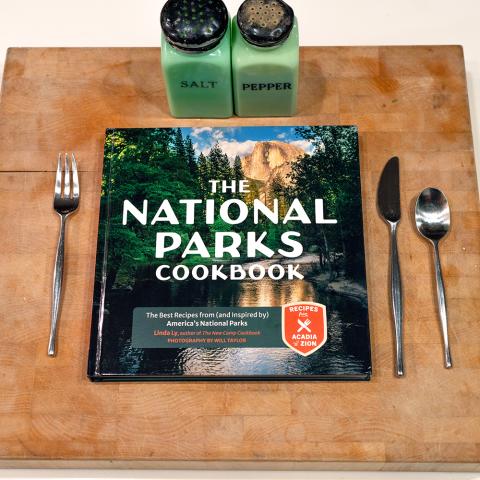
 Support Essential Coverage of Essential Places
Support Essential Coverage of Essential Places






